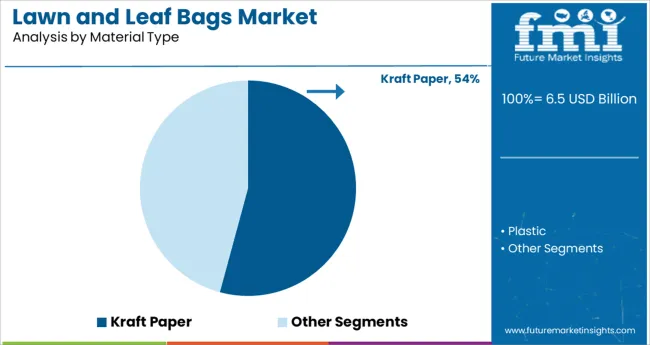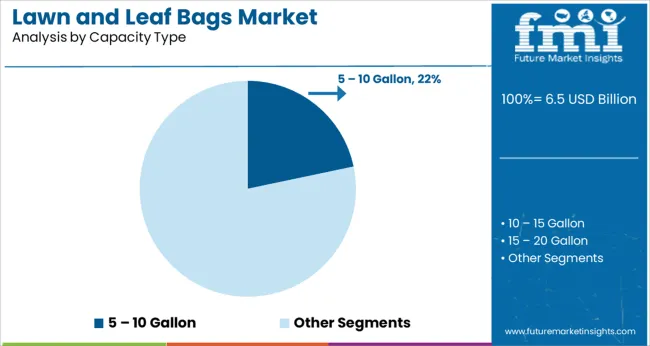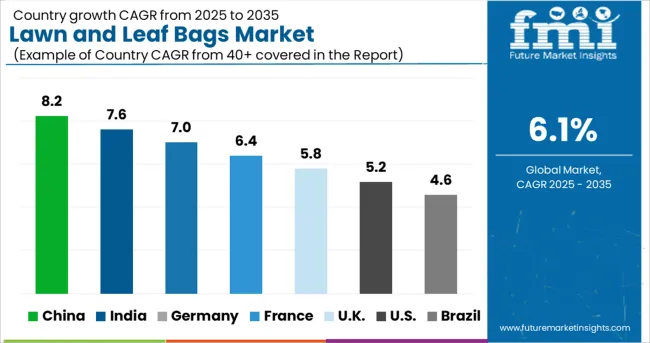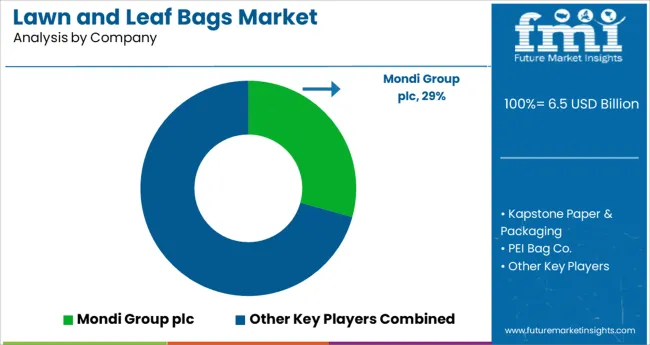The Lawn and Leaf Bags Market is estimated to be valued at USD 6.5 billion in 2025 and is projected to reach USD 11.8 billion by 2035, registering a compound annual growth rate (CAGR) of 6.1% over the forecast period.

The lawn and leaf bags market is witnessing consistent growth as environmental sustainability and waste management regulations continue to gain traction across municipalities and residential communities. Rising awareness around compostable yard waste solutions and bans on plastic bags in several regions have accelerated the transition to biodegradable and recyclable alternatives.
Municipal composting programs and seasonal yard maintenance cycles are contributing to increased demand for bags that are durable, easy to handle, and environmentally compliant. Advancements in moisture resistant coatings and wet strength reinforcement technologies have also supported performance under heavy or damp loads.
Additionally, increasing consumer preference for eco conscious home maintenance products has influenced purchasing behaviors. The market is expected to benefit from a blend of regulatory enforcement, material innovation, and consumer driven sustainability goals, fostering expansion opportunities across both residential and commercial landscaping segments.
The market is segmented by Material Type, Capacity Type, and End Use and region. By Material Type, the market is divided into Kraft Paper and Plastic. In terms of Capacity Type, the market is classified into 5 - 10 Gallon, 10 - 15 Gallon, 15 - 20 Gallon, 20 - 30 Gallon, and 30 Gallon & above.
Based on End Use, the market is segmented into Lawns & Gardens, Commercial & Industrial Use, and Domestic Use. Regionally, the market is classified into North America, Latin America, Western Europe, Eastern Europe, Balkan & Baltic Countries, Russia & Belarus, Central Asia, East Asia, South Asia & Pacific, and the Middle East & Africa.

The kraft paper segment is anticipated to account for 54.20 percent of total market revenue by 2025, establishing it as the dominant material type. This is attributed to its biodegradable nature, compatibility with composting systems, and structural durability for handling wet or heavy yard waste.
Municipal mandates encouraging the use of non-plastic yard waste bags have further propelled adoption. Manufacturers have prioritized kraft paper due to its recyclability, tensile strength, and cost efficiency in large scale production.
Additionally, its porous nature facilitates airflow, supporting decomposition in organic waste management. The increasing alignment of municipal guidelines and homeowner preferences with sustainable lawn care practices has reinforced kraft paper’s position as the material of choice in the lawn and leaf bags market.

The 5 to 10 gallon segment is expected to represent 21.70 percent of total revenue by 2025, emerging as a preferred capacity type. This size range offers a balance between portability and functional volume, catering primarily to small-scale yard cleanup tasks in residential settings.
The segment’s popularity is supported by its ease of handling, reduced risk of overloading, and suitability for older consumers or those with limited storage space. Additionally, it aligns well with seasonal yard activities where moderate amounts of leaves and trimmings are collected regularly.
As consumer demand continues to favor ergonomic, task specific solutions that minimize strain and improve usability, the 5 to 10 gallon capacity segment is expected to maintain a steady growth trajectory within the lawn and leaf bags market.
The growing trend of gardens and lawns outside homes and public parks is expected to drive the global demand for the lawn and leaf bags. These bags are available in various capacities ranging from 5 gallons, 10 gallons to 30 gallons. Customers can choose as per the amount of waste generated.
Most of the lawn and leaf bags so manufactured are biodegradable and compostable, which makes them the preferred choice. The advantage of lawn and leaf bags is that they stay upright, open and stable while filling garden waste into it. Also, bags made up of plastics can be reused and they can be lasts for years. They can be folded flat and stored when not in use.
These factors are expected to fuel the growth of global lawn and leaf bags market during the forecast period. A traditional practice is that in which grass clippings and leaves are left uncollected on the lawn, so they contribute as an organic matter and fertilizer for the gardens and parks. This factor is expected to hamper the growth of the global lawn and leaf bags market during the next decade.
North America and Europe regions are expected to drive the growth of global lawn and leaf bags market due to trend of gardens and lawns outside homes and high standard of living. APEJ and Latin America regions are expected to show moderate growth in the global lawn and leaf bags. Overall, the outlook for the global lawn and leaf bags is expected to be positive over the next decade.
A robust methodology was used to arrive at the market size of lawn and leaf bags. Both supply-side and demand side analysis were performed.

The report is a compilation of first-hand information, qualitative and quantitative assessment by industry analysts, inputs from industry experts and industry participants across the value chain.
The report provides in-depth analysis of parent market trends, macro-economic indicators and governing factors along with market attractiveness as per segments. The report also maps the qualitative impact of various market factors on market segments and geographies.
The key manufacturers of lawn and leaf bags were identified, and their revenues were tracked with the help of primary interviews and paid databases such as Factiva, Avention, and Morningstar, among others. The revenue generated by the sale of products business was carefully tracked for each company, from which, the revenue generation from the sale of lawn and leaf bags was mapped.
The production capacity of each key player was tracked. Based on the data, a tier analysis was performed to classify the companies under different revenue categories.
The demand for storing and shipping solutions was carefully tracked. The data was split among various end use segment for lawn and leaf bags to arrive at the demand. Various sources were cited to validate the numbers obtained, industry experts (sales and business heads of key companies, paid interviews with independent packaging consultants, etc.) were contacted, along with extensive desk research.

Few of the leading players operating in the global lawn and leaf bags market are:
The research report presents a comprehensive assessment of the market and contains thoughtful insights, facts, historical data, and statistically supported and industry-validated market data. It also contains projections using a suitable set of assumptions and methodologies. The research report provides analysis and information according to market segments such as geographies, application, and industry.
The global lawn and leaf bags market is estimated to be valued at USD 6.5 billion in 2025.
It is projected to reach USD 11.8 billion by 2035.
The market is expected to grow at a 6.1% CAGR between 2025 and 2035.
The key product types are kraft paper and plastic.
5 – 10 gallon segment is expected to dominate with a 21.7% industry share in 2025.






Full Research Suite comprises of:
Market outlook & trends analysis
Interviews & case studies
Strategic recommendations
Vendor profiles & capabilities analysis
5-year forecasts
8 regions and 60+ country-level data splits
Market segment data splits
12 months of continuous data updates
DELIVERED AS:
PDF EXCEL ONLINE
Lawn Aerators Market
Lawn and Garden Consumables Market Size and Share Forecast Outlook 2025 to 2035
Lawn And Garden Equipment Afterparts Market Size and Share Forecast Outlook 2025 to 2035
Lawn and Garden Equipment Market Size and Share Forecast Outlook 2025 to 2035
Robotic Lawn Mower Market Size and Share Forecast Outlook 2025 to 2035
Powered Lawn Mowers Market Analysis - Size, Share & Forecast 2025 to 2035
Riding Multi-Purpose Lawn Mower Market Size and Share Forecast Outlook 2025 to 2035
Android Automotive OS (AAOS) Market Size and Share Forecast Outlook 2025 to 2035
Anderson Cascade Impactor Market Size and Share Forecast Outlook 2025 to 2035
Andersen-Tawil Syndrome Treatment Market Trends - Growth & Future Prospects 2025 to 2035
Andro Supplements Market
Handheld Electrostatic Meter Market Size and Share Forecast Outlook 2025 to 2035
Hand Towel Automatic Folding Machine Market Size and Share Forecast Outlook 2025 to 2035
Handheld Ultrasound Scanner Market Size and Share Forecast Outlook 2025 to 2035
Handheld Tagging Gun Market Forecast and Outlook 2025 to 2035
Handheld Imaging Systems Market Size and Share Forecast Outlook 2025 to 2035
Sandwich Panel System Market Size and Share Forecast Outlook 2025 to 2035
Hand Tools Market Size and Share Forecast Outlook 2025 to 2035
Land Survey Equipment Market Size and Share Forecast Outlook 2025 to 2035
Handloom Product Market Size and Share Forecast Outlook 2025 to 2035

Thank you!
You will receive an email from our Business Development Manager. Please be sure to check your SPAM/JUNK folder too.
Chat With
MaRIA